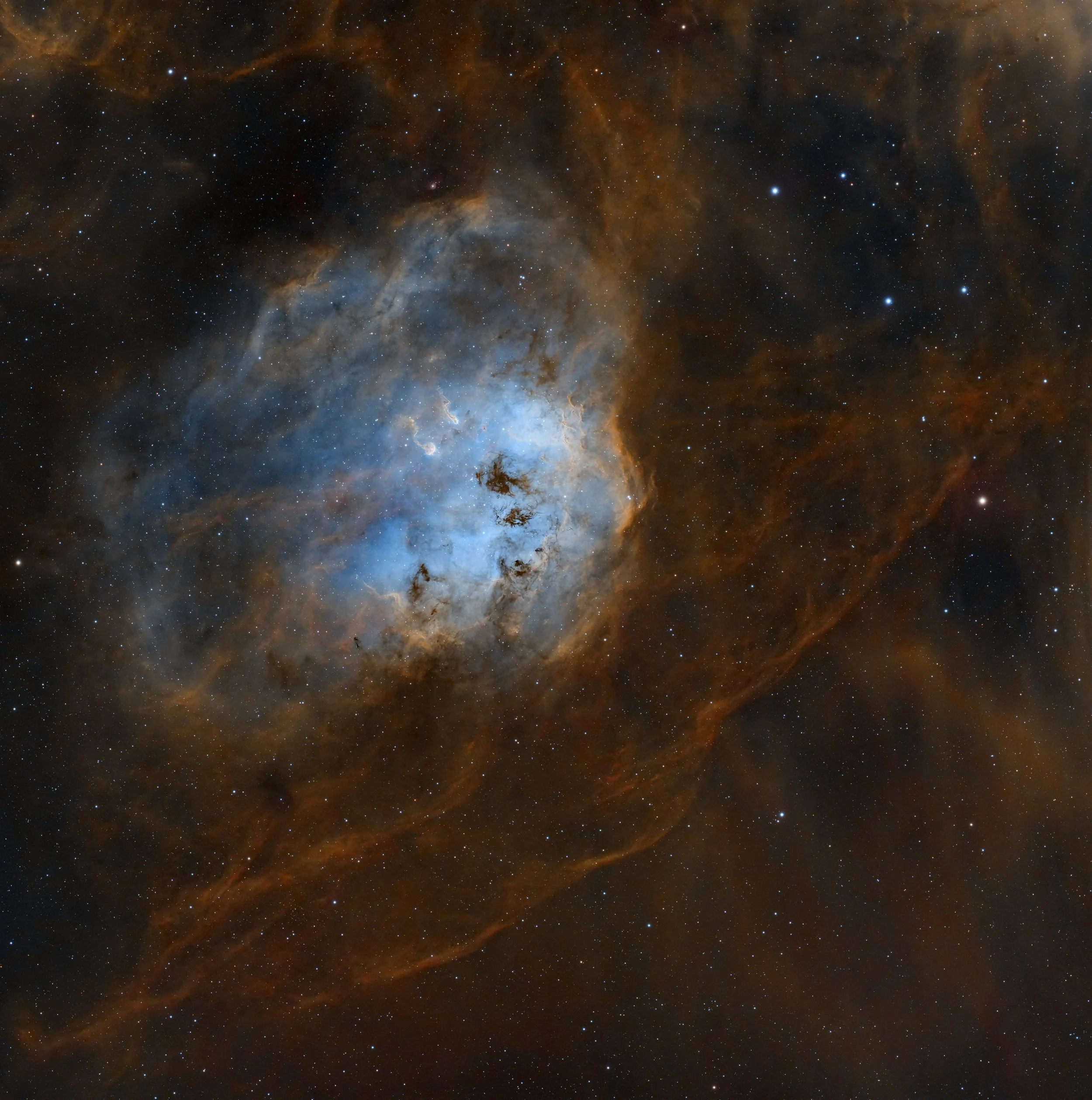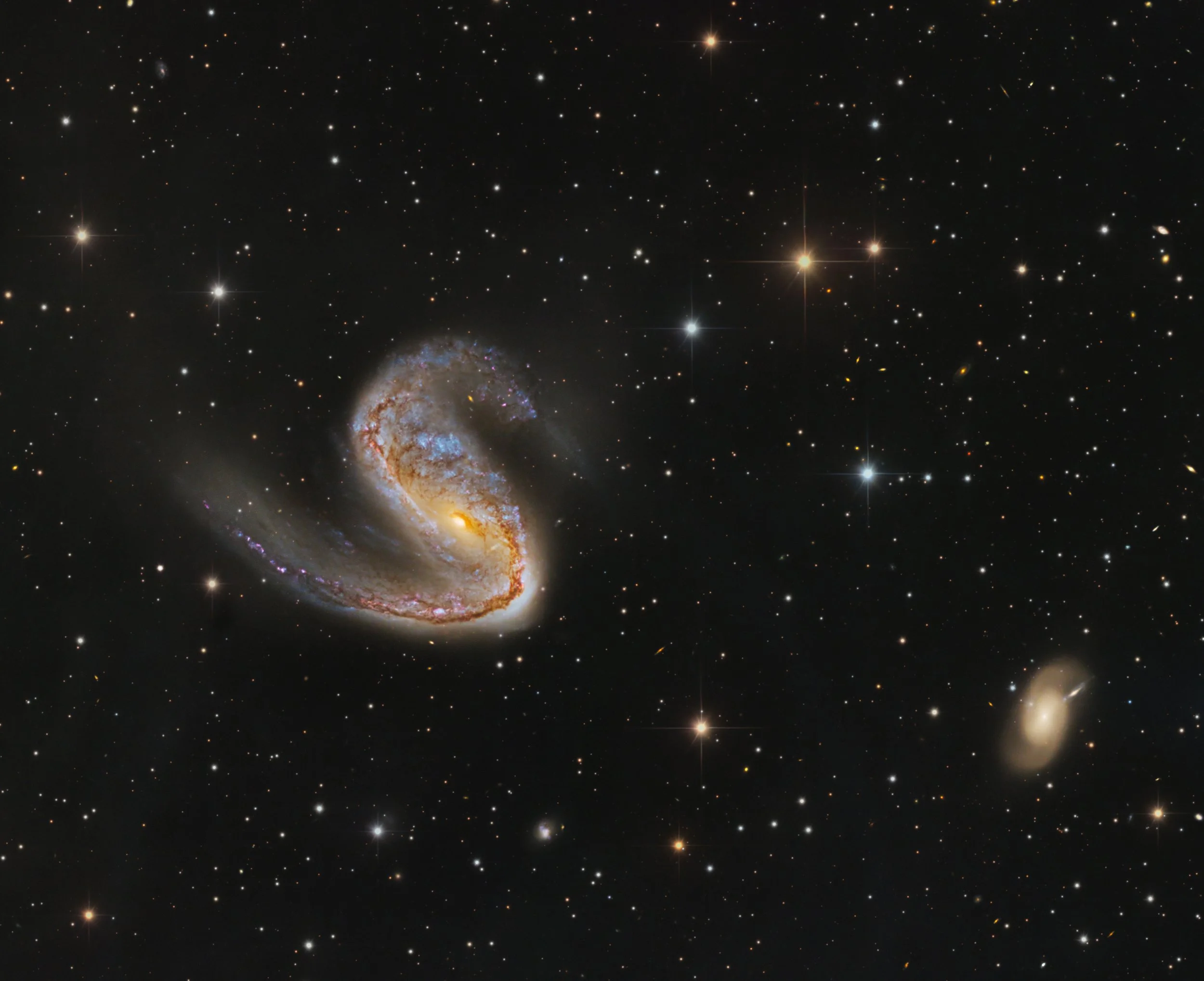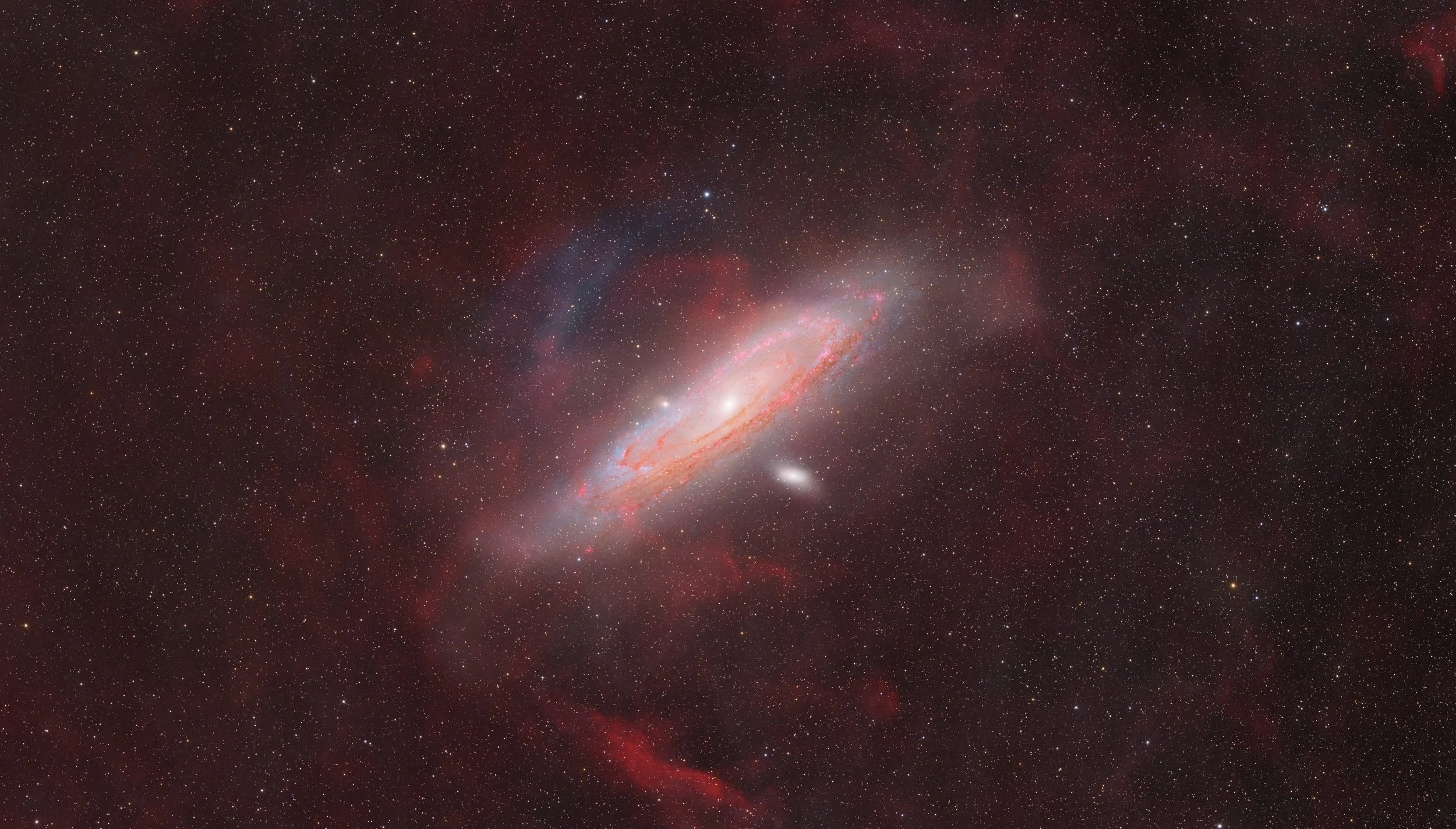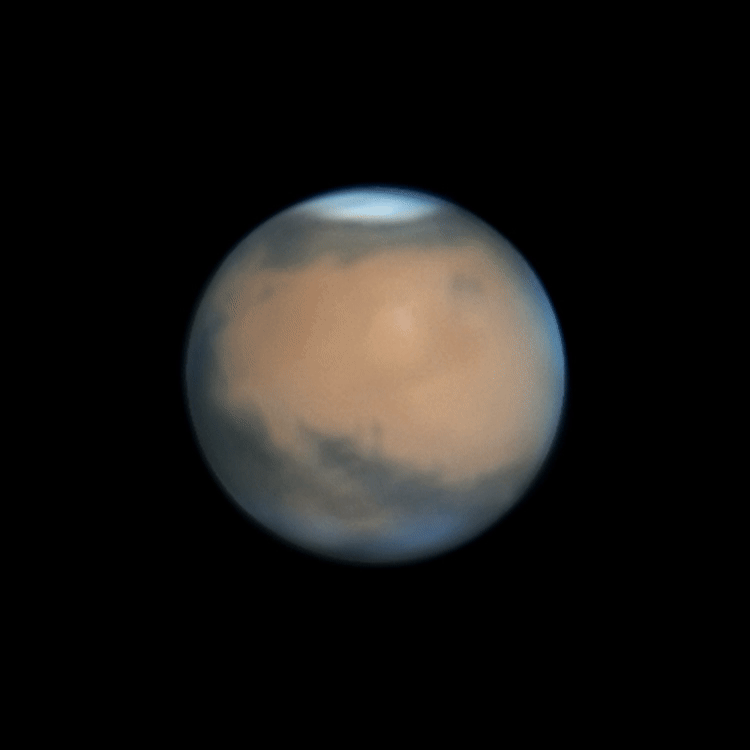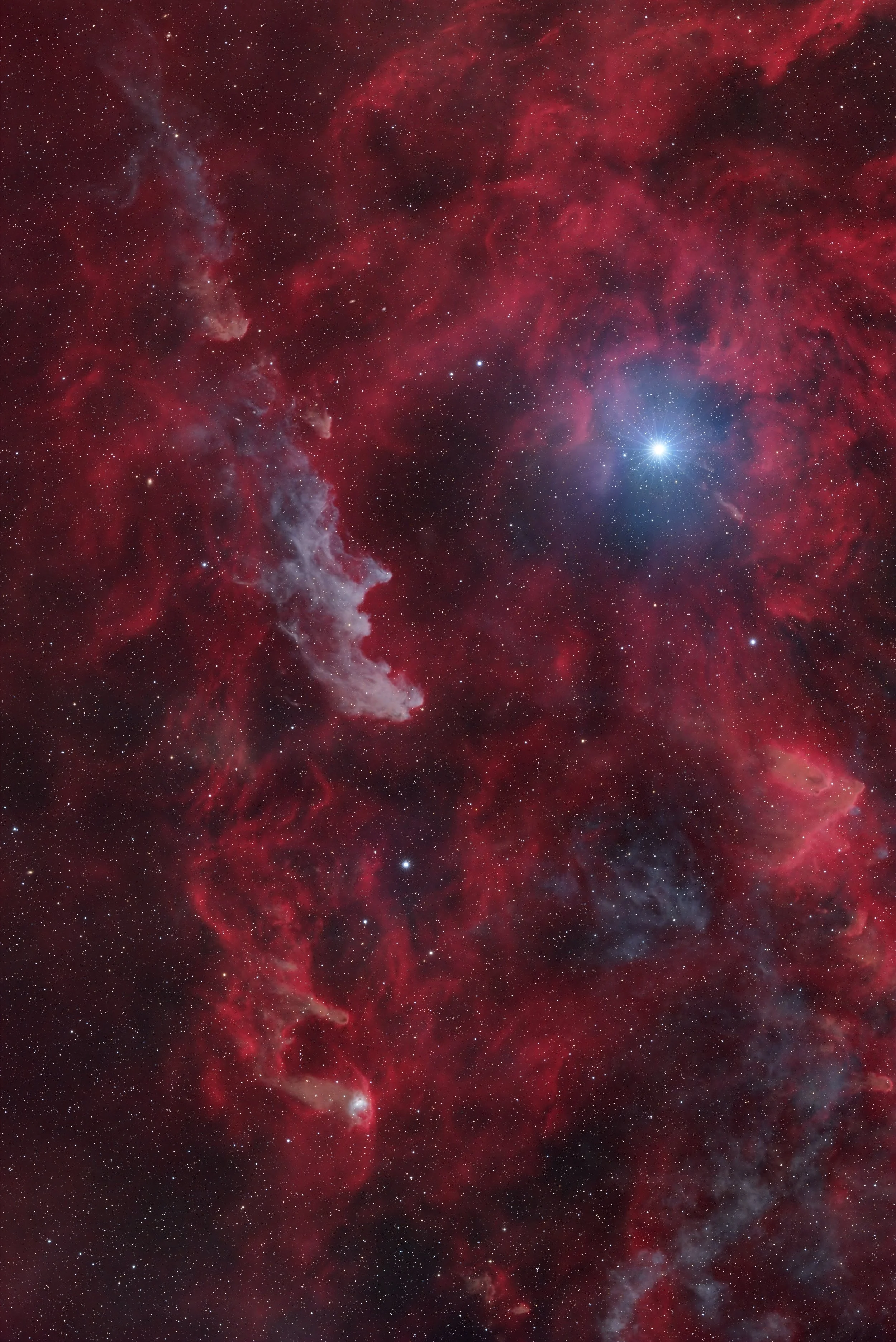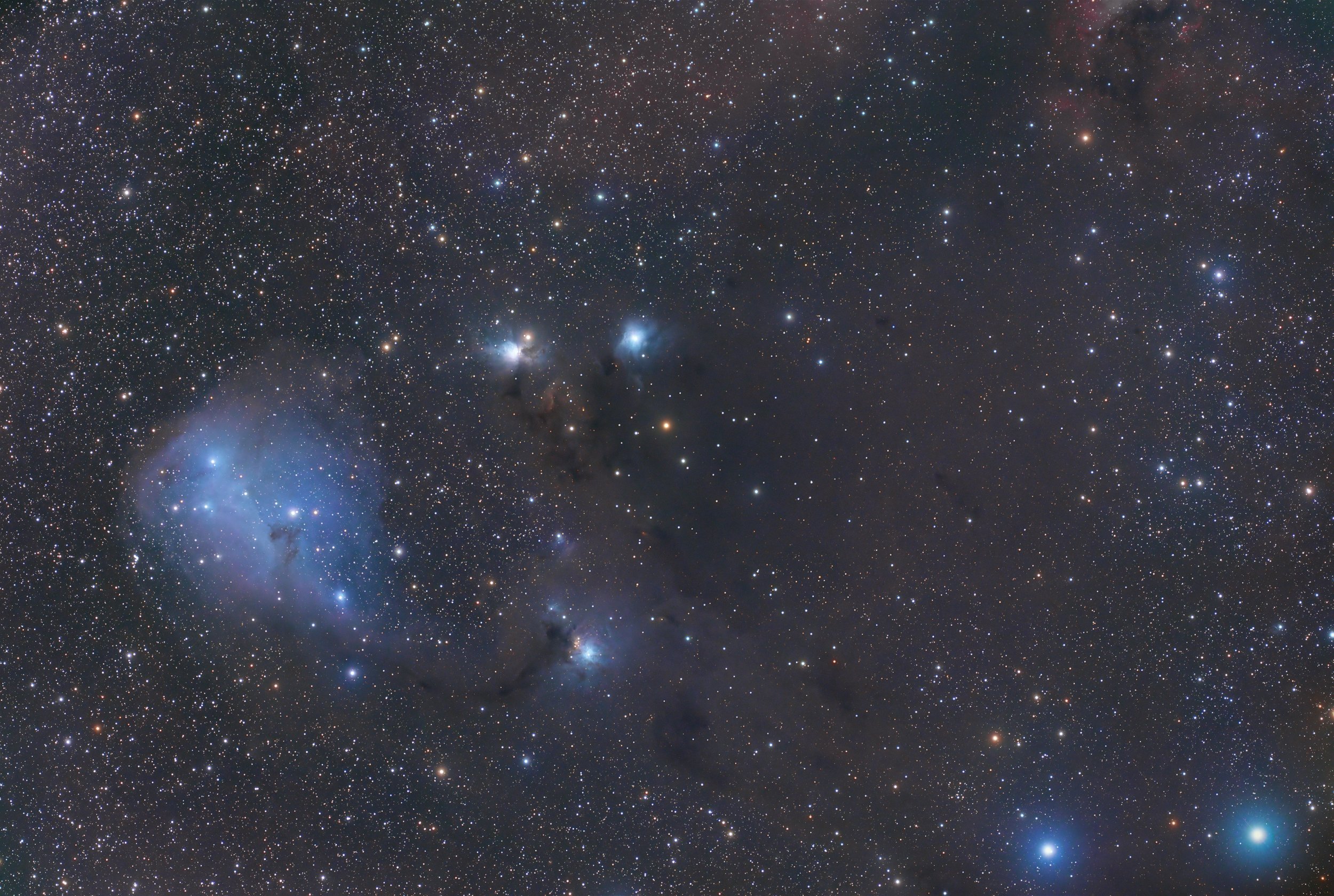
AAPOD2 Image Archives
M45 Les pléiades
The Pleiades, also known as M45, is one of the most recognizable open star clusters in the night sky. Located about 440 light-years away in the constellation Taurus, this young cluster is dominated by hot, blue B-type stars that illuminate the surrounding wisps of interstellar dust. These reflection nebulae create the characteristic blue glow, a result of fine dust scattering the starlight. While the cluster itself is estimated to be around 100 million years old, the nebulosity is not a remnant of its formation but rather a passing interstellar cloud through which the stars are currently moving.
Captured from Biars-sur-Cère, Occitanie, France, under moderate sky conditions, this image reveals the intricate interplay of light and dust surrounding the Pleiades. High dynamic range processing preserves the delicate filamentary structures of the reflection nebula while maintaining the contrast between the bright stars and the dark interstellar medium. The deep exposure also highlights faint surrounding gas, offering a glimpse into the complex environment of this stellar nursery.
The Tadpole Nebula
The Tadpole Nebula is a striking region of ionized hydrogen gas distinguished by its bright, compact “head” and an elongated, trailing “tail” of filamentary structures. This morphology, reminiscent of a tadpole, is sculpted by the dynamic interplay of stellar winds and ionizing radiation from nearby young stars, which compress and erode the ambient interstellar medium. Such processes not only reveal the intricate details of the nebula's structure but also provide valuable insights into the mechanisms of star formation and the evolution of molecular clouds.
Captured from Myślenice, Poland under Bortle 4 skies using a personal telescope setup, this SHO image was produced by carefully balancing multiple long exposures to preserve both the luminous core and the faint outer details. Through precise calibration and stacking of sub-exposures, the final composite reveals the nebula's full dynamic range, showcasing both the brilliant emission of the core and the subtle, diffuse glow of its trailing structures.
Fornax A – A Powerful Radio Galaxy
Fornax A (NGC 1316) is a lenticular galaxy in the Fornax constellation, approximately 60 million light-years away. It is one of the strongest radio sources in the sky, powered by a supermassive black hole at its core. Visible in optical wavelengths as a distorted elliptical galaxy, Fornax A reveals a history of galactic mergers through its dust lanes and complex shell structures. These remnants suggest past interactions with smaller galaxies, contributing to its irregular morphology.
This deep capture from Rio Hurtado, Chile, highlights the galaxy's intricate details, including its faint outer shell structures and the dense central region, where star-forming activity persists despite its classification as a lenticular galaxy. In radio wavelengths, Fornax A’s immense lobes—spanning nearly a million light-years—are powered by relativistic jets emanating from its central black hole. This galaxy provides a crucial laboratory for studying galactic evolution, merger dynamics, and the impact of active galactic nuclei on their surroundings.
M42 – The Orion Nebula in HDR-The Cosmic fire of creation
The Orion Nebula (M42) is one of the brightest and most studied star-forming regions in the night sky, located approximately 1,344 light-years away in the Orion constellation. This high-dynamic-range (HDR) image captures the nebula in unprecedented detail, balancing the luminous Trapezium Cluster at its core with the faint, intricate filaments of gas and dust extending outward. Achieved through meticulous exposure blending across multiple filters and sub-exposure lengths, this image preserves both the nebula's brilliant core and its dim outer structures, revealing the full depth of this stellar nursery.
M42 is an active star-forming region where massive young stars sculpt the surrounding hydrogen gas into complex, illuminated structures. The use of narrowband H-alpha and OIII filters isolates the ionized gas emissions, highlighting the nebula’s energetic processes, while broadband RGB and luminance exposures provide natural color and depth. The total integration time of over 26 hours ensures that even the faintest wisps of nebulosity are visible. This HDR composition offers a comprehensive view of one of the most iconic deep-sky objects, showcasing both its dynamic stellar interactions and its rich structural complexity.
NGC 300 – A Spiral Galaxy in Sculptor
NGC 300 is a stunning face-on spiral galaxy located approximately 6.5 million light-years away in the Sculptor Group, one of the closest galaxy groups to the Milky Way. With its loosely wound spiral arms and an abundance of young, hot stars, NGC 300 bears a strong resemblance to our neighboring Triangulum Galaxy (M33). It is a prime example of a late-type spiral galaxy, characterized by active star formation and an absence of a prominent central bulge.
This deep capture from Glanmire, Australia, reveals the intricate structure of NGC 300, highlighting its blue star-forming regions and the rich dust lanes scattered throughout its disk. The galaxy is also home to numerous HII regions, glowing clouds of ionized hydrogen where new stars are born. As one of the brightest and closest galaxies beyond the Local Group, NGC 300 serves as a valuable target for studying galactic structure, stellar evolution, and supernova remnants within its disk.
NGC 2442 - The Snake and the Mouse
NGC 2442, also known as the "Snake and the Mouse Galaxy," is a distorted spiral galaxy located approximately 50 million light-years away in the constellation Volans. Its asymmetric shape, marked by a dramatically warped spiral arm, is the result of a past gravitational interaction, likely with a smaller companion galaxy. This encounter triggered intense star formation, visible in the bright knots of young, blue stars along its arms.
The galaxy’s core remains relatively undisturbed, while one arm extends outward in a sweeping arc, earning it the nickname "the Snake." The opposing, shorter arm, rich in dust and active stellar nurseries, is often associated with "the Mouse." NGC 2442 is an excellent example of how galactic interactions shape and redefine galaxies over cosmic timescales, providing insight into the processes of tidal distortion and starburst activity in the universe.
Sh2-171 / NGC 7822 – A Stellar Nursery in Cepheus
Sh2-171, part of the larger NGC 7822 complex, is a bright emission nebula located in the constellation Cepheus, approximately 3,000 light-years away. This active star-forming region is home to massive, young stars that carve the surrounding gas into intricate shapes through intense ultraviolet radiation and stellar winds. At the heart of NGC 7822 lies the star cluster Berkeley 59, containing some of the hottest known stars in our galaxy, including O-type stars that emit powerful radiation, shaping the surrounding nebula.
This deep image captures the complex interplay of ionized hydrogen (Hα) and sculpted dust pillars, remnants of ongoing star formation. The nebula’s intricate filaments and dark globules represent dense regions where new stars are still forming. Sh2-171 provides an excellent laboratory for studying the effects of massive stars on their environments, as their radiation and winds disperse surrounding material, influencing the next generation of stellar birth.
Angel Nebula NGC 2170
NGC 2170, also known as the Angel Nebula, is a striking reflection nebula located in the star-forming region of Monoceros, approximately 2,700 light-years away. Unlike emission nebulae that glow due to ionized gas, reflection nebulae like NGC 2170 shine by scattering and reflecting the light of nearby hot, young stars. The nebula’s blue hues are the result of shorter-wavelength light scattering more effectively in the surrounding dust, similar to Earth's sky.
This RGB image showcases the nebula’s delicate structures, including interwoven dark filaments of cosmic dust and the warm glow of ionized hydrogen regions. NGC 2170 is part of the larger Monoceros R2 molecular cloud complex, an active stellar nursery where intense radiation and stellar winds shape the surrounding material. The intricate interplay of light and shadow in this region provides a glimpse into the early stages of star formation and the dynamic processes sculpting our galaxy.
Thor's Lightning (SNR G150.3+4.5), MarSai 1, Sh2-204, 207, 208, and 210 (Three-Panel Mosaic)
This expansive three-panel mosaic captures a rarely imaged region in the constellation Camelopardalis, featuring the supernova remnant G150.3+4.5—also known as “Thor’s Lightning”—alongside the faint emission nebulae MarSai 1 and Sharpless 204, 207, 208, and 210. Supernova remnant G150.3+4.5 is an ancient, diffuse structure, believed to be the remnants of a stellar explosion that occurred tens of thousands of years ago. Its faint filaments and ionized gas are difficult to detect, requiring long integration times and specialized narrowband filters to reveal its expanding shock fronts.
MarSai 1, a relatively newly cataloged nebula, adds to the complexity of the scene, while the Sharpless objects contribute a rich interplay of ionized hydrogen (Hα) emissions, sculpted by stellar winds and radiation from young, massive stars. Captured from the dark skies of Deep Sky West, this deep exposure highlights the intricate structure and faint details of these rarely studied objects, providing valuable insight into the late-stage evolution of massive stars and the impact of supernovae on the interstellar medium.
The Rosette
The Rosette Nebula (NGC 2237) is a vast emission nebula located approximately 5,200 light-years away in the constellation Monoceros. This stellar nursery spans over 130 light-years and is home to the young, energetic open cluster NGC 2244, whose intense radiation carves out the nebula’s intricate structure.
Captured from a Bortle 4 site in Myślenice, Poland, this image was processed in the Hubble Palette (SHO), where ionized sulfur (SII) appears red, hydrogen-alpha (Hα) green, and ionized oxygen (OIII) blue. This mapping enhances the nebula’s complex filaments and shock fronts sculpted by stellar winds and radiation pressure. The image reveals the nebula’s inner cavities, formed by the relentless forces of young, massive stars, offering a glimpse into the dynamic processes driving star formation in this iconic deep-sky region.
WR 8 - Rarely imaged Wolf Rayet star in HOO with RGB stars
WR 8 is a rarely imaged Wolf-Rayet star located in the southern constellation of Puppis. Wolf-Rayet stars are massive, evolved stars that undergo intense stellar winds, shedding their outer layers and enriching the surrounding interstellar medium with heavy elements. WR 8 belongs to this rare class, characterized by high surface temperatures and strong emission lines, particularly in ionized hydrogen (Hα) and oxygen (OIII).
Captured from the dark skies of Observatorio El Sauce, Chile, this image combines narrowband HOO data with RGB stars to preserve the natural colors of the field. The nebula surrounding WR 8 is shaped by powerful stellar winds interacting with previous ejecta, creating a complex structure of ionized gas. These turbulent regions are key to understanding the life cycles of massive stars and their impact on galactic evolution. The detailed exposure reveals intricate filaments and expanding shells, emphasizing the dynamic processes occurring in this rarely studied system.
The Seagull Nebula (IC 2177)
The Seagull Nebula (IC 2177) is an emission nebula located on the border of the Canis Major and Unicorn constellations. It is located about 3,800 light years from Earth. The nebula takes its name from its shape which evokes a seagull in flight, with well-extended "wings" and a "head" marked by a particularly bright region. It covers a vast region of the sky with an apparent size of about 120 arc minutes, four times the diameter of the full Moon. This nebula is mainly composed of clouds of ionized hydrogen, illuminated by young stars which emit strong ultraviolet light. The "head" of the Seagull is dominated by a bright star named HD 53367, a massive star of spectral type O. This nebula is a spectacular subject in imaging, for this I used filters duo band Hα/OIII and SII/Hb, which reveal details of the gas structures.
Abell 34
Abell 34 is a large, faint planetary nebula located in the constellation Hydra. It exhibits a distinct, nearly spherical structure with a characteristic bluish-green hue due to ionized oxygen (OIII) emissions. This evolved nebula represents the final stages of a dying star shedding its outer layers, leaving behind a hot white dwarf at its core.
Captured from Fregenal de la Sierra, Spain, this deep-sky image required long integration times to reveal the nebula’s delicate structure against the background sky. Its low surface brightness makes it a challenging target, requiring precise calibration and processing to enhance its faint details while preserving the surrounding field of stars.
104 hours on Andromeda at 135mm
The Andromeda Galaxy (M31), located approximately 2.5 million light-years from Earth, is the closest spiral galaxy to the Milky Way and one of the most iconic objects in the night sky. This image of Andromeda is the result of an extensive data collection process, utilizing over 100 hours of exposure time across multiple locations. The image showcases not only the galaxy’s core, but also the faint hydrogen-alpha (Ha) clouds and ionized oxygen (OIII) arc that encircle it.
Captured from two distinct locations, the first set of data was gathered from Texas, USA, at a remote observatory with dark, clear skies ideal for deep-sky imaging. The second set of data was captured from Calgary, Alberta, Canada, where urban light pollution posed additional challenges. Despite this, the combination of both data sets enabled a comprehensive view of the galaxy and its surrounding nebulosity.
Monoceros Space Garden: A Winter Mosaic
This mosaic captures two of the northern hemisphere’s winter classics—the Rosette Nebula and the Christmas Tree Cluster—nestled within the rich star fields of the Monoceros constellation. The Rosette Nebula, a vast star-forming region, glows with intricate filaments of ionized hydrogen, while the Christmas Tree Cluster, embedded within the Cone Nebula, adds a striking contrast with its young, hot stars shaping the surrounding gas and dust.
Captured from San Benedetto del Tronto, Italy, under Bortle 5 skies, this image combines narrowband and RGB data to enhance both the nebular structures and the surrounding starlight. The processing approach intensifies the dynamic interplay of colors while staying true to the physical emissions of ionized gases, creating a visually captivating yet scientifically grounded representation of this celestial landscape.
Rotation of Mars: A Dynamic View of the Red Planet
This animation captures an hour of Mars’ rotation, offering a rare glimpse into the planet’s ever-changing face. With a rotation period of 24.7 hours—remarkably close to Earth’s—Mars reveals its distinctive surface features in motion. The prominent carbon dioxide ice cap in the north stands out, while the planet’s thin atmosphere scatters light, producing subtle blue hues along the limb. Over the Elysium Mons region, delicate cloud formations drift, creating an almost three-dimensional effect as they shift with the planet’s rotation.
Captured from Murcia, Spain, this detailed sequence highlights the anticipation of Mars' closest approach, a moment that comes only once every two years. The animation showcases not just the planet’s geological diversity but also the dynamic nature of its weather patterns, making it a mesmerizing target for planetary observation.
HB3 Supernova
Hidden within the star-rich fields of Cassiopeia, the HB3 supernova remnant spans an immense 1.5° × 2° region of the sky. Estimated to have formed around 40,000 years ago, this ancient stellar explosion has left behind an intricate web of diffuse shockwaves and ionized gas. Situated near the more prominent IC 1705 (the Fish Nebula) and IC 1805 (the Heart Nebula), HB3 remains a challenging target due to its extremely faint emission.
Captured from Ager, Lleida, Spain, this deep exposure also reveals two planetary nebulae—PN G132.8+02.0 and PK131+02.1 (Abell 3)—delicate reminders of the quieter stellar deaths that contrast with HB3’s violent past. The image highlights the complexity of the interstellar medium, where remnants of stellar life cycles blend into the cosmic landscape, shaping the future of star formation.
IC 443, IC444, Sh2-249
IC 443, IC 444, and Sh2-249: A Cosmic Trio in Gemini
This captivating view in the constellation Gemini features the Jellyfish Nebula (IC 443), a supernova remnant with glowing tendrils of ionized gas, accompanied by the reflection nebula IC 444 and the faint emission region Sh2-249. IC 443 is the aftermath of a stellar explosion, with shockwaves shaping its intricate structure, while IC 444’s blue reflection comes from interstellar dust scattering the light of nearby stars. Sh2-249 provides a faint, reddish backdrop, completing this celestial trio.
Captured from Guidonia Montecelio, Italy, the image showcases the diversity of nebular forms and the dynamic processes shaping the interstellar medium. These structures illustrate the life and death of stars, from violent supernova remnants to tranquil regions of light and dust.
Rigel to the Witch Head Nebula and more
This wide-field view captures the dazzling blue supergiant star Rigel, the brightest star in Orion, and its spectral neighbor, the Witch Head Nebula (IC 2118). Rigel’s intense ultraviolet light illuminates the Witch Head, creating its ghostly blue glow as it reflects off interstellar dust. The intricate textures of the nebula resemble a witch's profile, adding a mythical touch to this cosmic scene.
Captured from SFRO in Texas, the image reveals the delicate interplay of light and dust stretching across this region of Orion. Surrounding faint nebulosity and subtle interstellar structures add depth to the composition, showcasing the vast, interconnected beauty of this celestial landscape. This dynamic pairing of star and nebula exemplifies the radiant harmony of the Orion region.
vdB 87
vdB 87 is a reflection nebula nestled in the constellation Cygnus, approximately 2,600 light-years from Earth. Its ethereal blue glow results from starlight scattering off nearby interstellar dust, creating a soft, ghostly illumination against the surrounding darkness. The nebula is part of a rich and complex region of star formation, adding depth to its celestial environment.
Captured from the Deep Sky West remote observatory near Santa Fe, NM, this image highlights vdB 87’s delicate structure and subtle contrasts. Reflection nebulae like vdB 87 are a visual testament to the interplay of light and matter, showcasing the quiet, luminous beauty hidden within the vast expanses of the Milky Way.



